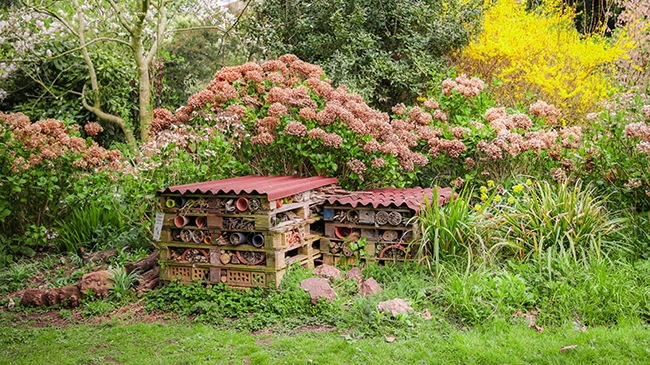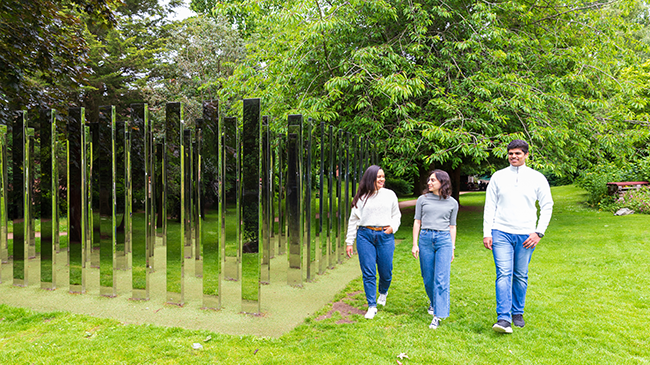Royal Fort Gardens
A popular, peaceful park open to the public for free all year round. Enjoy planted borders and sloping lawns, woodlands, pushchair-friendly paths and public art in this relaxing green space, a short walk from the top of Park Street.
On this page
Visiting and using the gardens
Royal Fort Gardens are open daily, all year round, to the public, staff and students.
You do not need to buy tickets or pay to use these gardens.
Address
Take the Royal Fort Gardens quiz
Get outside and take on our interactive Royal Fort Gardens quiz. Explore the public art, buildings and plant life around you. Whether it’s spotting a well-known sculpture or identifying flowers, you might learn something new.
Things to see and do
Enjoy a walk or picnic in this calm and beautiful garden. It has won a Green Flag award every year since 2016, for being a well-managed green space.
Talk with friends or sit alone, take a moment away from your lectures or work to listen to the birds and watch local wildlife.
Explore the mirror maze, spot frogs by the pond, and have a peaceful picnic in a green oasis away from the city rush.
More to see and do in these gardens:
- Garden map
- Trees and plants
- Wildlife and nature
- Self-guided walking tours
- Public art
- Volunteer
- Tell us about your visit
- Instagram for Royal Fort Gardens
Garden map
Download the Royal Fort Gardens guide and map (PDF, 1,256kB).
Trees and plants
Royal Fort Gardens contains a wide range of specimen trees and plants. You can use the interpretation board in the garden to find out what some of them are.
You'll find three big Lucombe oaks, along with a redwood and wellingtonia pine near the pond. We also have a beautiful olive tree. In the Hollow area, a big Kiftsgate rose blooms. You'll see memorial trees with their own stories. Plus, we have edible plants like rhubarb, raspberries, and strawberries. Don't miss the Acacia dealbata trees with their big flowers, as well as gingkos and fig trees.
We survey our trees annually, to monitor their health. You can see the name, location and detailed information about our trees, with photographs, on our tree map. Click or tap on a tree on the map for more information about it.
If you are in the garden, you use the QR codes on many of our larger or more unusual trees to access detailed information about them on the online map.
Seasonal interest
As you take a walk along the drive, be sure to admire the early flowering daffodils which add a splash of colour to our landscape and signal the arrival of spring.
In spring and summer, explore the Royal Fort meadow and Teaching Awards tribute wildflower meadows. Here flowers attract pollinators and enhance the biodiversity of our lawn areas. These carefully cultivated meadows offer a pretty setting for relaxation and reflection.
In the autumn, enjoy the stunning seasonal colours as our trees prepare for winter.
Wildlife and nature

Royal Fort Gardens are home to a diverse array of wildlife, including foxes, bats, birds such as jays and woodpeckers, if you are lucky you may even spot a sunbathing lizard. Explore the pond to discover aquatic life like newts, toads, and frogs. Keep an eye out for peregrines nesting in the Physics Building nearby.
To support wildlife, we've created habitat areas with dead hedges and specific structures. This includes the 'toad abode' near the pond and bug hotels near the shed and on the wall in the Hollow area. These features provide shelter and encourage biodiversity, with standing dead wood offering additional homes for various creatures.
Self-guided walking tours
Take a self-guided walking tour to find out more about all the things in the Royal Fort Garden.
Royal Fort Gardens guide and map (PDF, 1,256kB).
You can also pick up a copy from the display case next to Royal Fort Lodge.
Public art

There are several works of public art in or near Royal Fort Gardens, which you can visit for free.
Permanent artworks include:
- Follow Me mirror maze by Jeppe Hein
- Henrietta Lacks statue by Helen Wilson Roe
- Hollow immersive artwork by Katie Paterson
- Voroni Screen by WilkinsonEyre and Professor Peter Green
- Palm Temple immersive artwork by Luke Jerram
Find further works of public art on permanent display around the University.
Volunteer
Students and staff can join organised volunteering sessions helping the Gardens and Grounds team in our gardens.
Volunteering activities include:
- general maintenance including weeding and fence building
- bulb planting and seed sowing
- building and maintaining homes for wildlife.
To find out how to take part in volunteering activities:
- staff, contact us
- students, find University-organised volunteering opportunities on the events calendar or volunteering opportunities organised with the SU in the Students' Union's What's On events list
- students, if you want to volunteer with us regularly, join the Students' Union's Conservation Group
Tell us about your visit
We'd love to hear about your visit to Royal Fort Gardens. What did you enjoy? What do you think could be improved? Send us your anonymous feedback.
Instagram for Royal Fort Gardens
See what others are doing in the garden and add your own images #royalfortgarden or tag us in your stories @uobroyalfortgardens.
Facilities
- Access
- Parking
- Bike storage
- Refreshments and toilets
- Seats and benches
- Table tennis tables
- Code of conduct
- Hiring Royal Fort Gardens
Access
There is a level approach to Royal Fort Gardens on Tyndalls Avenue, at the intersection with Woodlands Road. What3words location: either.pill.solved
In the gardens, there are smooth paths that you can use with a push-chair or wheelchair. Some paths are sloping.
Parking
There is no dedicated parking at Royal Fort Gardens. There is metered parking in the streets around the gardens.
Bike storage
You can store your bike near Royal Fort Gardens.
Students, find where you can park your bike on campus.
Refreshments and toilets
The nearest University Source Cafe is Senate House Marketplace. This is open to the public.
There is a toilet at the Source Cafe.
Find Source Cafe opening hours.
There is a drinking water fountain near the Physics building, What3words location: salad.slams.pies.
There are several local cafes and shops on Park Street and around The Triangle.
Seats and benches
There are several benches near the path all around the gardens.
Table tennis tables
There are two table tennis tables which you can use, near the Physics building. You must bring your own bats and balls.
Code of conduct
These are public gardens, and we expect visitors to treat the space and each other with respect and courtesy.
- Take your litter home with you.
- Only assistance dogs are allowed; keep dogs on leads and clean up after your dog.
- Supervise children.
- Stick to paths, avoid disturbing wildlife, and don't damage property, trees, plants or lawns.
- No barbecues, fires, camping, skateboarding, or aggressive cycling.
- Follow additional safety instructions, if there are building works taking place.
Hiring Royal Fort Gardens
You can hire Royal Fort Gardens for your own event or function.
To hold an event at the Royal Fort Gardens:
- staff, contact External Events on SharePoint
- members of the public, contact our Venues and Events team.
History of the site and the garden design
Find out more about the history of the site how the garden design has evolved.
At the end of the 18th century, there was an unsuccessful attempt to develop the gardens for housing. Renowned landscape architect Humphry Repton was subsequently commissioned to design a new garden, to hide the unsightly housing excavations.
Repton's design was in the 'English Landscape' fashion and complimented the classical Georgian Royal Fort House. He created undulating lawns and added a high wall to surround and retain the gardens. The wall acted as a 'ha-ha', screening local buildings and giving unspoiled views to the hills around Bristol.
Research in Royal Fort Gardens
Our gardens and green spaces are often used for research projects involving:
- small mammals such as bats and birds
- larger mammals such as badgers and foxes
- insects such as moths and bees.
We welcome researchers and research projects from various disciplines, including archaeology, art history, biological sciences, geography and geology.
